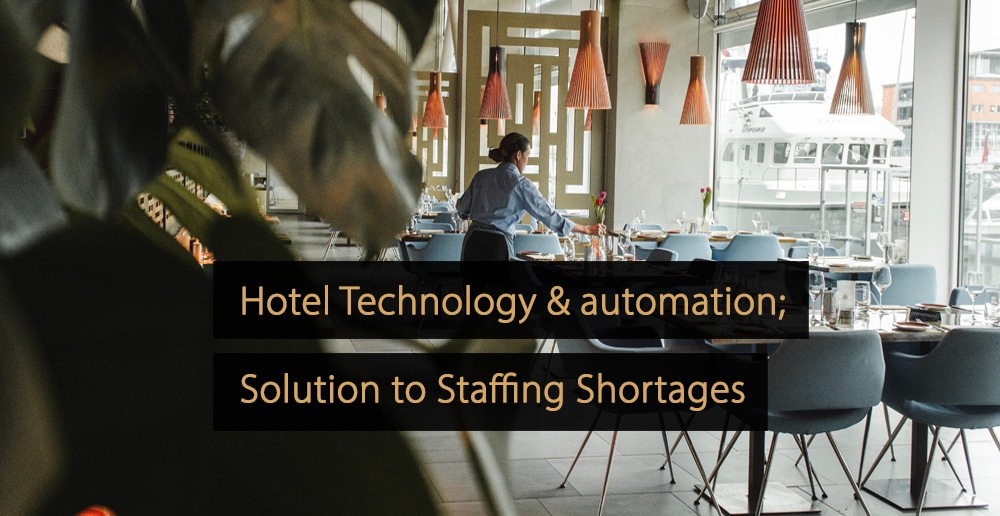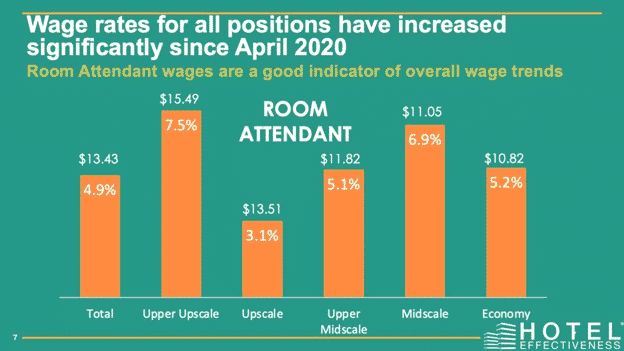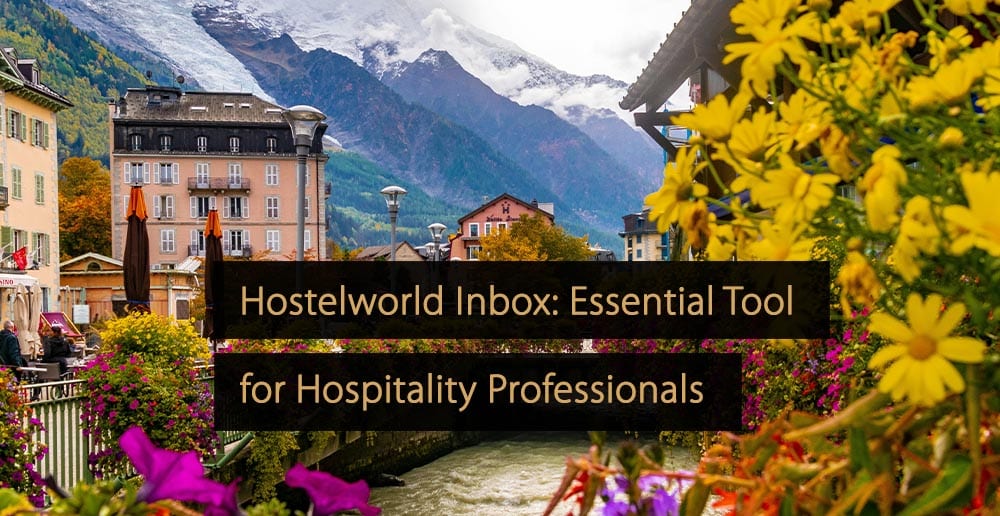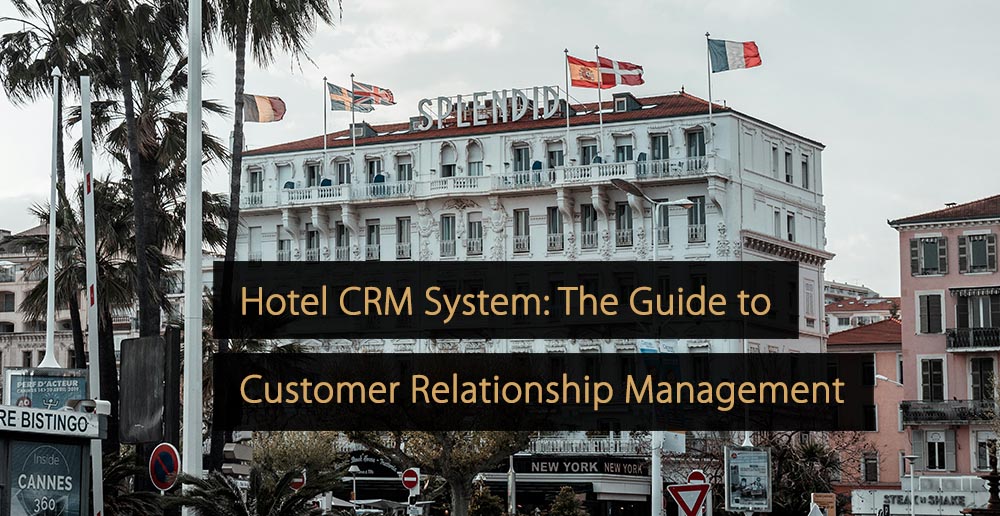Lograr que los huéspedes regresaran después de que se levantaron las restricciones de viaje no fue un desafío para la mayoría de los hoteles. Pero recuperar al personal que abandonó la industria ha resultado difícil. Como resultado, la falta de personal se ha convertido en una de las consecuencias más duras de la pandemia para los hoteles. Esto crea nuevos problemas para una industria que aún se recupera de meses de cierres. Pero si bien no existe una única solución, puedes abordar varios aspectos de este desafío a la vez con las herramientas adecuadas.
Un viejo problema regresa con venganza
Encontrar y retener empleados excelentes nunca fue fácil para los hoteles, ni siquiera antes de la pandemia. Las tasas de rotación en el sector hotelero siempre han sido relativamente altos. En Estados Unidos, llegaron a casi 74% en 2016. Pero la pandemia empeoró aún más las cosas.
Muchas empresas hoteleras tuvieron que despedir a personal competente o suspenderlo durante el confinamiento. Sin embargo, cuando se levantaron las restricciones y los hoteles buscaron recontratar a ex empleados, muchos no regresaron. ellos habian tomado empleos en otras industrias que ofreciera mejores condiciones laborales y beneficios.
Como resultado, aproximadamente 1,6 millones de puestos de hostelería están abiertos sólo en los Estados Unidos, pero pocas personas quieren llenarlos. La situación es similar en otros países como el Reino Unido y Alemania. Como consecuencia, 94.5% de hoteles dicen que hoy no tienen suficiente personal.
Cómo afecta la escasez de personal a los hoteles
La falta de personal trae consigo una serie de implicaciones para un hotel. Para empezar, los equipos existentes deben asumir una mayor carga de trabajo. Hacen horas extras y tienen demasiadas tareas, lo que afecta negativamente su salud mental. Esto da como resultado un estándar de servicio más bajo y una oferta reducida (por ejemplo, horarios de apertura limitados de los restaurantes). La reputación de un hotel se verá afectada cuando la experiencia de los huéspedes se deteriore.
La falta de tiempo también dará lugar a una formación insuficiente del personal, lo que significa que los miembros del equipo increíblemente inexpertos seguirán siendo menos productivos. El peor resultado es cerrar establecimientos o dejar de vender habitaciones porque significa perder ingresos a pesar de la demanda existente.
Los hoteles de todo el mundo intentan abordar estas dificultades y atraer nuevos empleados ofreciendo salarios más altos y mejores ventajas. Este es un método excelente para hacer que su lugar de trabajo sea más atractivo. Pero prepárese para que su rentabilidad se vea afectada al principio hasta que la productividad mejore y pueda aumentar el RevPAR.
Fuente: Datos salariales históricos de efectividad hotelera, >5000 hoteles en EE. UU.
Cabe resaltar que no todos los hoteles se ven afectados de la misma manera por este problema. 5.3% de las propiedades afirman que no les falta personal. Esto plantea una pregunta interesante: ¿qué hacen estos hoteles de manera diferente?
La respuesta es sencilla: aprovechan la automatización para más cosas que sus competidores fuertemente afectados. Veamos cómo podría funcionar eso en su hotel.
Automatización: su salvavidas en tiempos de escasez de personal
El objetivo de utilizar la automatización es simple: ahorrar tiempo eliminando o minimizando la necesidad de actividades repetitivas y que consumen mucho tiempo. Los ejemplos de la recepción incluyen check-in/check-out, ventas adicionales y responder repetidamente a las mismas consultas.
Tomemos como ejemplo el check-in online. Aquí la automatización puede liberar tiempo de su personal y producir una mejor experiencia para los huéspedes. El sistema solicita a los huéspedes que proporcionen su documento de identidad y los datos de su tarjeta de crédito antes de su llegada. El PMS envía esta información al sistema de pago mediante integración y todos los trámites se realizan antes de que el huésped cruce la puerta.
Envíe a los invitados una clave móvil y ya no tendrán que esperar. Pueden entrar a su habitación inmediatamente. Sólo deberán recoger la llave en recepción a su llegada. Esto facilita el check-in para los viajeros y deja a su equipo con más tiempo para interactuar de manera significativa con los huéspedes.
Gestión de ingresos: un candidato principal para la automatización
Por supuesto, la automatización también puede hacer maravillas en los departamentos internos. La gestión de ingresos tiene mucho potencial, ya que los sistemas automatizados pueden hacerse cargo de tareas manuales y ayudarle a generar más ingresos.
Estos son los tres elementos principales de la gestión de ingresos que puede automatizar.
1. Recopilación y organización de datos
Debido a que el enfoque manual requiere mucho tiempo, rara vez produce datos confiables en tiempo real. Como resultado, todavía se toman decisiones sobre precios y distribución sin información suficiente y se pierden oportunidades de ingresos.
Un sistema automatizado de gestión de ingresos (RMS) hace esto por usted. Recopila continuamente datos internos históricos y registrados (OTB) y competidores en tiempo real y demanda prospectiva conocimientos en tiempo real. Esto muestra los cambios en vivo en la demanda, lo que le permite actuar de inmediato basándose en la información más actualizada y precisa.
2. Actualizaciones de tarifas
Actualizar sus tarifas manualmente lleva mucho tiempo. Eso significa que es posible que su equipo solo pueda modificar los precios mucho después de que la demanda haya cambiado, ya que tienen muchas otras cosas que hacer. Es probable que esto le cueste sus oportunidades de ingresos y podría generar cobros excesivos o insuficientes.
Un RMS automatizado puede hacer que las cosas avancen más rápido. Recopila grandes conjuntos de datos las 24 horas del día, los 7 días de la semana, los 365 días del año y los analiza para identificar cambios en el mercado en vivo. Cuando el RMS detecta un cambio, recibe sugerencias de precios optimizadas de inmediato. El RMS envía estas nuevas tarifas a su PMS y canales de distribución tan pronto como las apruebe. ¡Eso significa el fin de las actualizaciones manuales de tarifas!
Ahora podrás mantener tu posicionamiento en todo momento y aprovechar cada oportunidad. Pero si no tiene tiempo para comprobar las sugerencias del RMS de inmediato, es posible que aún pierda algunas oportunidades.
Vaya un paso más allá e implemente precios totalmente automatizados. Esta configuración completamente autónoma permite que el RMS actualice las tarifas de las habitaciones automáticamente las 24 horas del día, los 7 días de la semana. Le ahorra la mayor cantidad de tiempo y le garantiza que aprovechará al máximo cada oportunidad para generar ingresos por habitaciones.
Un ejemplo de la vida real

Martín relata: “Nuestro pequeño equipo se ocupa de muchas tareas diferentes cada día. Queremos dedicar el menor tiempo posible a cada herramienta y aun así obtener el máximo. Esa es una de las cosas que apreciamos mucho del Atomize. Ajusta automáticamente nuestras tarifas de habitaciones y captura oportunidades de ingresos y precios. Esto eliminó la tediosa tarea de fijar manualmente los precios y al mismo tiempo mejoró nuestro RevPAR, un doble beneficio”.
3. Previsión de ingresos por habitaciones
Los mercados impredecibles de hoy han dificultado los pronósticos porque los datos históricos ya no tienen poder predictivo. Recopilar y evaluar datos para hacer predicciones y elaborar pronósticos manualmente cuesta mucho tiempo. Sin embargo, la precisión del pronóstico seguirá siendo baja porque se verá obligado a confiar en su instinto.
Un RMS automatizado acelera su proceso de pronóstico mensual. Actualiza la proyección de ingresos por habitaciones utilizando datos de OTB, demanda y mercado en vivo. Siempre que el mercado y sus precios cambian, el sistema ajusta automáticamente sus predicciones. Esto también es beneficioso para los equipos de operaciones, ya que les permite planificar mejor y gestionar sus recursos. En pocas palabras, su proceso de previsión de ingresos se vuelve dinámico.
Como puede ver, confiar en un RMS innovador para automatizar las tareas de gestión de ingresos tiene muchas ventajas.
Guía gratuita: la combinación definitiva de herramientas para una gestión de ingresos exitosa
Como administrador de ingresos, conoce las dos limitaciones principales en su campo: datos y tiempo. Los datos son esenciales ya que le permiten comprender lo que está sucediendo en su industria.
En esta guía, aprenderá cómo la tecnología puede mejorar su toma de decisiones y aumentar sus resultados al permitirle obtener datos de mayor calidad rápidamente.
Haga click aquí para descargar la guía "Aumente el rendimiento de su gestión de ingresos con tecnología hotelera".
La automatización ayuda a los equipos más pequeños a hacer más en menos tiempo; puede aprovechar al máximo todas las oportunidades de ingresos y aumentar sus ingresos incluso en los turbulentos mercados actuales. Esto le permite ofrecer salarios y beneficios más competitivos sin poner en peligro sus resultados. Dada la dura competencia actual por los huéspedes y el personal, asegurar estas ventajas para su hotel es lo único inteligente que puede hacer.
Más consejos para hacer crecer su negocio
Revfine.com es la plataforma de conocimiento líder para la industria de la hospitalidad y los viajes. Los profesionales utilizan nuestros conocimientos, estrategias y consejos prácticos para inspirarse, optimizar los ingresos, innovar los procesos y mejorar la experiencia del cliente.Explore el asesoramiento de expertos sobre gestión, marketing, revenue management, operaciones, software y tecnología en nuestro sitio web dedicado. Hotel, Hospitalidad, y Viajes y Turismo categorías.









Leave A Comment